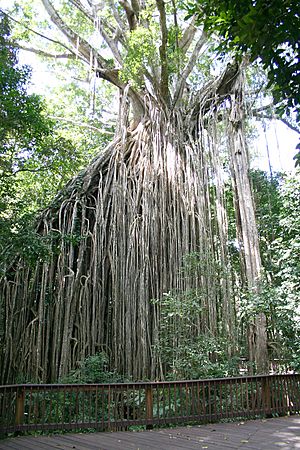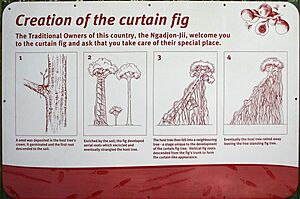Curtain Fig Tree facts for kids
Quick facts for kids Curtain Fig Tree |
|
|---|---|

Curtain Fig Tree
|
|
| Location | Curtain Fig Tree Road, Yungaburra, Tablelands Region, Queensland, Australia |
| Official name: The Curtain Fig Tree | |
| Type | state heritage (landscape) |
| Designated | 3 December 2009 |
| Reference no. | 602734 |
| Significant period | 1920s |
| Lua error in Module:Location_map at line 420: attempt to index field 'wikibase' (a nil value). | |
The Curtain Fig Tree is a very special old tree located on Curtain Fig Tree Road in Yungaburra, Queensland, Australia. It's one of the biggest trees in Tropical North Queensland and a famous spot on the Atherton Tableland. Because it's so unique, it was added to the Queensland Heritage Register on December 3, 2009, meaning it's protected for future generations to enjoy.
Contents
How the Curtain Fig Tree Grows
The Curtain Fig Tree is a type of tree called a strangler fig. These figs have a very interesting way of growing! Usually, a strangler fig seed lands high up on another tree. It then sends its roots down towards the ground. Once these roots reach the soil, the fig tree starts to grow very quickly.
As the fig grows, its roots wrap tightly around the host tree. Eventually, the host tree can't get enough sunlight or nutrients and dies. The fig tree then stands on its own. For the Curtain Fig Tree, something extra special happened. The host tree it was growing on started to lean over towards another nearby tree. The fig's roots grew around that second tree too!
The most amazing part is how its roots hang down like a giant curtain. These roots drop about 15 meters (49 feet) to the ground. Even though strangler figs cause their host trees to die, they are not parasites. They are called epiphytes, which means they get their food from the ground, not from the host tree's sap.
History of the Curtain Fig Tree
The famous Curtain Fig Tree is found in the Curtain Fig National Park. It's about one kilometer north of Yungaburra on the Atherton Tableland. Experts from the Queensland Parks and Wildlife Service believe this tree is at least 500 years old! It has been a popular tourist spot since the 1920s. This tree helped make the Cairns area a big tourist destination in Queensland.
The Mabi Rainforest
The tropical forests of the Atherton Tableland have been known by different names over time. In the 1960s, scientists called a special type of forest here "mabi rainforest." This name comes from a local Aboriginal word for the rare Lumholtz's tree-kangaroo. This kangaroo is the largest mammal found in this type of forest. Sadly, a lot of mabi rainforest has been lost due to logging, farming, and towns. It is now listed as an endangered forest type.
Early Visitors and Tourism
When people first visited the Atherton Tableland, they were amazed by the thick, green forests. They loved the huge trees covered in vines, and the beautiful ferns and orchids. Some early tourist places, like Fairyland and the Maze in Kuranda, showed off this amazing nature.
Over time, people's views of the rainforest changed. In the 1920s, people started to see nature as a connected system. They realized that all living things, including humans, depend on their environment. Groups like the North Queensland Naturalists' Club worked to change how people talked about the rainforest. They wanted people to use words like "jungle" instead of "scrub," to show more respect for these special places.
Giant strangler figs like the Curtain Fig Tree were seen as natural wonders. The unique shape of the Curtain Fig Tree was created when its roots strangled its host tree. The host tree then fell at an angle into another tree. The fig's long roots then dropped 15 meters (49 feet) to the forest floor, creating the "curtain" shape we see today. Pictures of these amazing fig trees appeared in newspapers and on postcards as early as the 1900s.
The Rise of Tours
Descriptions of unusual trees like the Curtain Fig Tree started appearing in tourist guides in the 1920s. The Curtain Fig Tree became a well-known attraction. Around 1926, a local car service called Whitecars began offering day tours of the southern Tableland. They would stop so people could see the giant tree. Before this, the only easy way to travel to the southern Tableland was by train.
Whitecars helped tourism grow a lot on the Tablelands. In 1926, the Gillies Highway opened, connecting the southern Tableland with Cairns. This brought many more tourists. Whitecars started taking passengers between Cairns and the Tableland. They also offered day tours from Yungaburra. By 1934, they even had a bus that could carry 17 passengers! Whitecars played a big part in making places like the Curtain Fig Tree famous.
Modern Tourism and Protection
By the 1950s, the Curtain Fig Tree was part of big tours like the "Grand Tour" and "Tropical Wonderland Tour." These tours were promoted by the Queensland Government Tourist Bureau. Many tourists from cities like Melbourne and Brisbane would visit Cairns and then take a Whitecars tour to see the Tableland attractions, including the Curtain Fig Tree.
As more people owned cars in the 1960s, even more tourists came to the Cairns area. The Curtain Fig Tree continued to be a very popular stop. It was included in many different tours throughout the 1970s.
Today, the Curtain Fig Tree is still a major tourist attraction. But now, we understand more about nature. The area around the tree has changed to protect it. There are signs that teach visitors about the tree's formation and the mabi rainforest. A boardwalk guides visitors around the tree, allowing them to see it from all sides without harming the forest floor. In December 1988, the Curtain Fig became part of the Wet Tropics World Heritage Area. This means it's part of a huge, protected rainforest area.
A special boardwalk was built in 2001. It allows people in wheelchairs to visit the tree easily. It also helps protect the tree and its surroundings. Many thousands of tourists visit the Curtain Fig Tree every year, either on their own or as part of a tour.
What the Curtain Fig Tree Looks Like
The Curtain Fig Tree is found in the Curtain Fig National Park. The forest around it is a special type called mabi rainforest, which is now endangered.
The tree is about 50 meters (164 feet) tall. Its trunk is about 39 meters (128 feet) around! The top part of the tree, called the canopy, spreads out about 30 meters (98 feet) from the trunk. The most striking feature is its many aerial roots. These roots are now very thick and woven together. They hang down about 15 meters (49 feet) to the ground, forming a "curtain" that is about 7 meters (23 feet) wide. The original host tree that the fig grew on has long since rotted away. Now, the fig tree stands completely on its own.
To get to the Curtain Fig Tree, you walk along a 2-meter (6.5 feet) wide wooden boardwalk from the car park. At the start of the boardwalk, there's a sign that tells you about the mabi rainforest and the history of the tree. The boardwalk then goes all the way around the Curtain Fig. This boardwalk is great for wheelchairs and is raised above the forest floor. This helps protect the rainforest from visitors. Another sign explains how the tree got its unique shape.
You might see some old timber posts and stones at the base of the tree. These are left over from an older boardwalk that used to be much closer to the tree.
Why the Curtain Fig Tree is Special
The Curtain Fig Tree was added to the Queensland Heritage Register in 2009. This means it's recognized as very important for several reasons:
- It shows how Queensland's history has changed. The Curtain Fig Tree is a 500-year-old strangler fig. It has been a part of organized tourism on the Atherton Tableland since the 1920s. It shows how much people love visiting the natural places in Far North Queensland. Its popularity grew even more when cars became common, making it easier for tourists to visit. The tree was seen as a wonder of nature by early settlers. It has been one of the most visited large trees on the Tableland for nearly 100 years and is still very popular today.
- It is beautiful and unique. The Curtain Fig Tree is a huge and very special tree. It stands in a rare mabi rainforest. People value it for its enormous size and the amazing "curtain" made by its thick, woven roots. The tree's lush, green growth has been admired by locals and tourists since the 1920s. It truly makes people feel amazed and curious.


